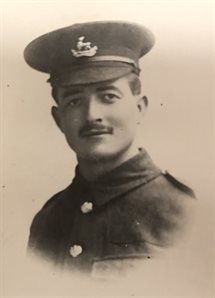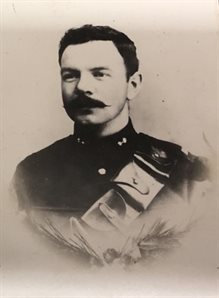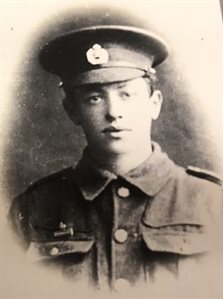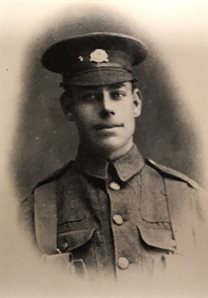Harlington and the First World War
The Vicar of Harlington, Rev. A. G. Hodgson, compiled a memorial booklet which was published in January 1921, a copy of which is held by Bedfordshire Archives as part of the parish collection (reference P75/28/14). The booklet included biographical notes and photographs of parishioners who lost their lives during the First World War. The following extracts provide a sample of the booklet’s contents:
Harold Wakeling Apthorpe

Born at Keysoe, North Beds., July, 1892; came to Harlington 1894. He was at school here and later at Bedford Modern. He entered Saltley College, Birmingham, and passed out with distinction. Heserved two masterships in Birmingham, and became Head Master of the School at Cople, Beds.
Being a member of the College Territorial Corps, he enlisted in his old regiment, the Warwickshires, and was quickly promoted to be Sergeant. He transferred early in 1915 to the 1st Warwicks for overseas duty, landing at Havre, March 23. He was home on leave in December, and out again in France till he fell in the great advance of July 1, 1916, “gallantly leading his men”. From another letter it is known that they reached the fourth German line, where he was seen to fall. Afterwards, being outflanked, our men withdrew, leaving dead and wounded in the hands of the enemy.
Charles William Asbury

Was born and brought up at Harlington, and became a porter on the Midland Railway. Later he enlisted, and served in England and in India. Returning, he worked in Bedford as clerk of the Territorial Association.
On the outbreak of the War, as a Reservist, he rejoined at once the R.F.A. [Royal Field Artillery], and was at Mons and in the Marne and Somme battles. He was killed with two others by back-fire from the gun he served.
His officer wrote of him, “a good soldier, and not easily replaced.”
Sidney Charles Cleaver

Born Dec. 28, 1895, enlisted from Radlett in the R.E’s [Royal Engineers], and sent for training to Bedford, Peterborough and Norwich. He fought on the Gallipoli Peninsula, 1915, and was in hospital with dysentry in Cairo. Transferred to the 1/5 Beds., he fought in Palestine and was wounded in the neck. He met his death by a shell in the fighting before Jerusalem, and was buried in the Judean Hills. A cross at his grave there bears his name and the date, April 8, 1918.
G. Lawman was his companion in the early part of the war. H. Bonner was near him when he fell.
[Additional notes: Sidney Cleaver was the son of John and Emma Cleaver of the Rising Sun; he was buried at Ramleh War Cemetery. His brother Walter was killed just 17 days later, fighting with the 1st Bedfords at the Battle of the Lys.]
Edward Francis Harris

Born and brought up at East End, Harlington. He worked for Mr. John Giles, and later at the Cement Works.
He enlisted 1914 in the Bedfordshires, and was out in France with the 2nd Beds. Regt., April 2, 1915. Three weeks later he fell at Festubert, and was “buried near the old German trench which he gallantly helped to take.” Later his body was moved and buried at Ypres.
He was the first of the men of this village to die for the great cause of the Allied Armies.
[Additional notes: Edward Harris was the son of John and Florence Harris of Sundon Road; he is remembered on the Le Touret memorial. A detailed description of the attack by the 2nd Bedfords in which he was killed can be found on our Bedfordshire at War blog]
Richard Henry Starling

Born at Catford, was taken by the Waifs and Strays Society, sent to Harlington at about 14 years of age and brought up by Mr. And Mrs. J. Richardson in the Bute Cottages. For some time a bellringer at Church, he was employed chiefly at the Cement Works.
He enlisted at Bedford Sept., 1914, in the 4th Beds. Regt., and fell in battle August 1915. A letter from his Corporal states that he died in the “Clearing Station”; and a Nurse wrote, “We have buried him in the little cemetery”.
[Additional notes: The Commonwealth War Graves Commission gives his place of birth as Chingford, Essex, rather than Catford, and his father’s address as New South Wales, Australia]